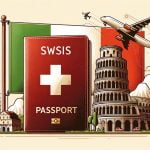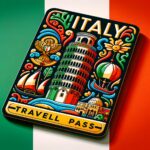The Swiss Travel Pass is a popular choice for travelers visiting Switzerland, offering unlimited travel on the country’s extensive rail, bus, and boat network. With this pass, visitors have the freedom to explore Switzerland’s picturesque landscapes, charming towns, and vibrant cities with ease. However, for those looking to venture beyond Switzerland’s borders and experience the beauty of neighboring countries like Italy, a common question arises: Can the Swiss Travel Pass go to Italy?
Before delving into the specifics of traveling to Italy with the Swiss Travel Pass, let’s first understand what this pass entails. The Swiss Travel Pass provides unlimited access to various modes of transportation within Switzerland, including trains, buses, boats, and even some mountain excursions. It offers flexibility and convenience for exploring different parts of the country at your own pace.
However, when it comes to venturing outside of Switzerland’s borders, it is important to understand the geographical coverage of the pass. While Switzerland shares its borders with several countries including Germany, France, Austria, and Italy itself, whether or not you can use your Swiss Travel Pass to travel to these countries varies. And in particular for our focus here – can the Swiss Travel Pass go to Italy?
Exploring the Swiss Travel Pass
The Swiss Travel Pass is a comprehensive travel pass that allows visitors to explore Switzerland using an extensive network of trains, buses, boats, and even some mountain railways. With the Swiss Travel Pass, travelers can conveniently hop on and off public transportation without having to worry about purchasing individual tickets or passes. It offers unlimited travel for a fixed period of time, making it a cost-effective and convenient option for those looking to explore the country.
One of the main benefits of the Swiss Travel Pass is its flexibility. Travelers have the freedom to choose their own itinerary and can travel anywhere within Switzerland using the pass. Whether you want to explore bustling cities like Zurich and Geneva or immerse yourself in the picturesque landscapes of Zermatt or Lucerne, the Swiss Travel Pass has got you covered.
Additionally, the pass includes various other bonuses and discounts that make it even more enticing for travelers. With the Swiss Travel Pass, you can enjoy free access to many museums and attractions throughout Switzerland. You also get discounted prices on mountain excursions, scenic trains like the Glacier Express or Bernina Express, and even some regional transportation in neighboring countries.
The Swiss Travel Pass is available for different durations, ranging from 3 to 15 consecutive days, allowing travelers to choose a pass that suits their specific needs. It is worth noting that children under 16 years old who are traveling with at least one parent can travel for free with the complimentary Swiss Family Card.
The convenience and value offered by the Swiss Travel Pass make it an excellent choice for exploring Switzerland. Whether you’re visiting for a few days or planning an extended trip, this pass provides unlimited access to various modes of transportation while also offering additional perks like museum entry discounts.
Understanding the Pass Zones and Boundaries
The Swiss Travel Pass is a popular travel option for exploring Switzerland, offering unlimited access to various modes of transportation such as trains, buses, boats, and even some mountain railways. However, it is important to understand the pass zones and boundaries to make the most of this convenient travel pass.
The Swiss Travel Pass is divided into different zones, which correspond to specific regions within Switzerland. These zones determine the areas where the pass can be used for free travel. The coverage includes nearly all destinations throughout Switzerland, making it an excellent choice for those wanting to explore the country extensively.
In addition to the extensive coverage within Switzerland, the Swiss Travel Pass also allows for limited travel in neighboring countries. This means that holders of the pass can venture outside of Switzerland and explore nearby cities and attractions. However, it is important to note that while the Swiss Travel Pass offers some advantages in terms of crossing borders, there are limitations when it comes to traveling to Italy.
Italy is not included in the coverage area of the Swiss Travel Pass by default. This means that holders of the pass will need additional tickets or passes if they wish to travel from Switzerland to Italy. However, there are certain exceptions where part of the journey between Switzerland and Italy may be covered by the Swiss Travel Pass.
For example, if you are traveling from Zurich or Geneva to Italian cities such as Milan or Venice through direct trains operated by Trenitalia or Eurocity (EC), your Swiss Travel Pass will cover your journey until Chiasso (the last station before crossing into Italy). From Chiasso onwards, you will need separate tickets for your Italian destination.
It’s also worth noting that some scenic train routes that cross into Italy may offer a discount for Swiss Travel Pass holders. For instance, the Bernina Express connects Chur in Switzerland with Tirano in Italy via spectacular mountain scenery.
Although you would still need separate tickets from Tirano onwards if you want to explore further into Italy, taking advantage of the discounted leg of the journey can be a great way to combine your Swiss exploration with a taste of Italy.
Overall, while the Swiss Travel Pass allows for convenient and unlimited travel within Switzerland, additional tickets or passes will be required for exploring Italy. It is recommended to plan your itinerary accordingly and consider all necessary arrangements before embarking on your Swiss-Italian adventure.
Discovering the Neighboring Countries
Introduction
The Swiss Travel Pass is a popular choice for travelers exploring the stunning landscapes, charming towns, and vibrant cities of Switzerland. With its comprehensive coverage and convenient features, it offers a hassle-free way to navigate the country’s efficient public transportation system. But what about using the Swiss Travel Pass to venture beyond Switzerland’s borders? Can it take you to neighboring countries like Italy? Let’s explore the possibilities.
Understanding the Pass Coverage
Before delving into whether the Swiss Travel Pass can be used to travel to Italy, it’s important to understand its coverage within Switzerland itself. The pass allows unlimited travel on trains, buses, boats, and even mountain lifts within Switzerland. It also includes free admission to many museums and attractions and offers discounted rates for certain scenic train routes and cable cars.
Exploring Neighboring Countries
While the primary focus of the Swiss Travel Pass is on exploring Switzerland, it does offer some options for venturing into neighboring countries like Italy. However, it’s worth noting that these opportunities are limited and come with certain restrictions.
One of the key features of the Swiss Travel Pass is its inclusion in the Eurail system. This means that holders of a valid Swiss Travel Pass can enjoy free travel on certain trains that connect Switzerland with other European countries. These trains include some direct routes from major Swiss cities like Zurich or Geneva to major Italian cities such as Milan or Venice.
However, it’s important to check specific timetables and availability as some trains may require reservations or additional fees even with a Swiss Travel Pass. Additionally, while the pass may cover your journey up to the border between Switzerland and Italy, there may be additional costs or requirements for traveling within Italy itself.
Traveling to Italy with the Swiss Travel Pass
If you’re considering using the Swiss Travel Pass to visit Italy, it’s important to understand the requirements and limitations involved. While the Swiss Travel Pass provides excellent coverage within Switzerland, its use in Italy is subject to certain conditions.
Firstly, it’s essential to note that the Swiss Travel Pass does not offer unlimited travel throughout Italy. Instead, it allows for a one-way trip from Switzerland to an Italian border station and back within a 24-hour period. This means that you can explore Italian cities near the Swiss border for a day trip but cannot use the pass for extended travel within Italy.
To make use of this one-way trip option, there are some requirements and procedures to keep in mind. Before crossing the border into Italy, ensure that your Swiss Travel Pass is valid and has been activated for your intended travel date. It’s also crucial to carry a valid passport or identity card as you’ll need it when crossing national borders.
When planning your itinerary, take into account that the journey within Italy must be completed by direct trains operated by either Trenitalia or SBB-CFF-FFS (Swiss Federal Railways). These trains typically run between major cities close to the border such as Milan, Como, Domodossola, and Tirano.
While exploring Italian cities with your Swiss Travel Pass, remember that it only covers train travel within Italy. Any additional modes of transportation such as buses or boats will require separate tickets or passes. Additionally, attractions or activities in Italy may have their own admission fees which are not covered by the pass.
By understanding these requirements and limitations, you can plan your trip effectively and make the most of your time in Italy using the Swiss Travel Pass. Next, we’ll discuss how you can seamlessly transition from Switzerland to Italy with this pass in hand.
Crossing the Border
One of the great advantages of the Swiss Travel Pass is its flexibility when it comes to crossing borders and exploring neighboring countries. While the pass primarily covers travel within Switzerland, it does offer some options for venturing into Italy. In this section, we will explore how to seamlessly transition from Switzerland to Italy using the Swiss Travel Pass.
To cross the border from Switzerland to Italy with your Swiss Travel Pass, you have a few options. If you are traveling by train, the most common method is taking a direct train from a Swiss city to an Italian city. Many major cities in Switzerland, such as Geneva, Zurich, and Basel, offer direct train connections to popular Italian destinations like Milan, Rome, and Venice.
An important thing to note is that while the Swiss Travel Pass will cover your journey up until the border town or station in Switzerland, it may not necessarily cover the entire trip to your final destination in Italy. Depending on your specific pass type and additional fees required for international travel, you may need to purchase a separate ticket for the portion of your journey in Italy.
Here is a step-by-step guide on using your Swiss Travel Pass to cross the border:
- Check train connections: Look up train schedules and connections between your departure city in Switzerland and your desired destination in Italy. Make note of any transfers or changes required along the way.
- Validate your pass: Before boarding the train in Switzerland, be sure to validate your Swiss Travel Pass at a ticket machine or customer service desk if it hasn’t been validated already. This allows you to use the pass for travel within Switzerland and get it stamped before crossing into Italy.
- Purchase additional tickets if necessary: Depending on your pass type and coverage limitations, you may need to purchase additional tickets for certain portions of your journey in Italy. Check with customer service or at the train station beforehand to ensure you have all necessary tickets.
- Board the train: Once you have your validated Swiss Travel Pass and any additional tickets, board the train bound for Italy. Follow any instructions or signs at the train station to locate your designated platform.
By following these simple steps, you can smoothly transition from Switzerland to Italy using your Swiss Travel Pass. Now that you know how to cross the border, let’s explore some of the fantastic Italian cities and attractions you can visit with your pass in hand.
Exploring Italian Cities with the Swiss Travel Pass
Italy is a country known for its rich history, breathtaking scenery, and renowned cultural sites. With the Swiss Travel Pass, travelers have the opportunity to not only explore Switzerland but also venture into neighboring countries such as Italy. This section will focus on the major attractions and destinations within Italy that can be visited using the Swiss Travel Pass.
One of the most popular cities in Italy is Milan, known for its fashion and design scene. With the Swiss Travel Pass, tourists can easily travel from Switzerland to Milan using the train network. Once in Milan, visitors can explore famous landmarks such as the Duomo di Milano, one of Europe’s largest cathedrals, or enjoy world-class shopping in Galleria Vittorio Emanuele II. Museo del Novecento and Leonardo da Vinci’s Last Supper are also must-visit attractions.
Another enchanting city to explore with the Swiss Travel Pass is Florence. Known as the birthplace of Renaissance art and architecture, Florence boasts iconic landmarks such as the Duomo, Ponte Vecchio, and Palazzo Vecchio. Additionally, art lovers can indulge in visiting world-renowned museums like Uffizi Gallery and Accademia Gallery where Michelangelo’s David resides.
The eternal city of Rome should not be missed when traveling to Italy with a Swiss Travel Pass. From ancient Roman ruins like Colosseum and Roman Forum to Vatican City where St. Peter’s Basilica and Sistine Chapel are located – there is no shortage of historical sites to explore in Rome. Don’t forget to toss a coin into Trevi Fountain for good luck.
These are just a few examples of the many Italian cities that can be explored using the Swiss Travel Pass. Whether it’s visiting Venice’s charming canals or admiring Pompeii’s preserved ancient ruins near Naples – there is something for everyone in Italy. The Swiss Travel Pass provides the convenience of unlimited train travel, allowing travelers to seamlessly explore these major attractions and destinations within Italy.
Tips for Making the Most of your Swiss Travel Pass in Italy
Italy is a popular destination for travelers, and many tourists who visit Switzerland with the Swiss Travel Pass wonder if they can use the pass to explore Italy as well. While the Swiss Travel Pass primarily covers travel within Switzerland, there are certain benefits and options available to travelers who want to visit Italy.
One of the key recommendations for making the most of your Swiss Travel Pass in Italy is to take advantage of the discounts offered by the pass. Although the pass does not provide free travel in Italy like it does in Switzerland, it does offer discounted fares on certain train routes between Brig, Domodossola, and Milan. This means that you can enjoy reduced prices on your train journey from Switzerland to Italy, making it more affordable and budget-friendly.
Another insider tip is to plan your trip strategically around the Swiss-Italian border towns. For example, if you are visiting Lugano in southern Switzerland, you can easily cross over into Como in northern Italy using your Swiss Travel Pass. From Como, you can further explore other Italian cities such as Milan or even venture into other regions like Tuscany or Venice by purchasing separate train tickets.
Additionally, it is important to note that while your Swiss Travel Pass may cover transportation within certain Italian cities such as Milan or Lake Como (within their respective transport networks), it will not cover attractions or museum entry fees. Therefore, it is advisable to research and plan ahead for any additional costs that may be incurred during your visit to these Italian cities.
To summarize, while the primary focus of the Swiss Travel Pass is on traveling within Switzerland, there are opportunities to explore parts of Italy with discounted fares. By taking advantage of these benefits and planning strategically around border towns, travelers can make the most of their Swiss Travel Pass and have a worthwhile experience exploring Italy as well.
| Tips for Making the Most of Your Swiss Travel Pass in Italy |
|---|
| Plan strategically around Swiss-Italian border towns |
| Take advantage of discounted fares between certain Swiss and Italian cities |
| Research and plan for additional costs within Italian cities |
Reaching Italy’s Famous Regions with the Swiss Travel Pass
Italy is a country known for its diverse regions, each offering unique landscapes, culture, and history. With the Swiss Travel Pass, travelers have the opportunity to explore some of Italy’s most famous regions while enjoying the convenience and cost savings of the pass. This section will provide a guide to the different regions of Italy and their accessibility with the Swiss Travel Pass.
- The Lake Como Region: Located in Northern Italy, Lake Como is a stunning destination known for its picturesque lakeside towns and stunning mountain scenery. With a Swiss Travel Pass, travelers can easily reach this region by taking a train from Switzerland to the town of Como. From there, they can explore charming villages such as Bellagio and Varenna or take a boat tour to enjoy the views of the lake.
- The Dolomites: For nature lovers and adventure enthusiasts, the Dolomites in northeastern Italy are a must-visit destination. With their jagged peaks and breathtaking alpine scenery, this region offers endless hiking trails, ski slopes, and outdoor activities. Travelers can reach this region from Switzerland by taking a train to Bolzano or Bressanone and then continue their journey into the heart of the Dolomites.
- Tuscany: Known for its rolling hills, vineyards, and Renaissance cities such as Florence and Siena, Tuscany is a popular region to visit in Italy. With a Swiss Travel Pass, travelers can easily make their way from Switzerland to Florence by train.
Once in Florence, they can explore its rich art scene, visit famous landmarks such as the Duomo or Uffizi Gallery, or venture out into the Tuscan countryside to discover charming towns like San Gimignano or Pienza. - The Amalfi Coast: One of Italy’s most iconic destinations, the Amalfi Coast is famous for its dramatic cliffsides dotted with colorful villages overlooking clear blue waters. To reach this region, travelers with a Swiss Travel Pass can take a train to Naples and then continue their journey by ferry or bus to the towns of Positano, Amalfi, or Ravello.
Exploring the charming coastal towns, sampling delicious local cuisine, and relaxing on beautiful beaches are among the many highlights of this region.
The Swiss Travel Pass opens up a world of possibilities for travelers looking to explore Italy’s famous regions. With its extensive coverage and convenience, it allows for seamless travel across the border from Switzerland into Italy. Whether you’re interested in breathtaking lakes, stunning mountains, vibrant cities or picturesque coastlines, there is a region in Italy waiting to be discovered with the help of the Swiss Travel Pass.
Conclusion
In conclusion, the Swiss Travel Pass offers a convenient and cost-effective way to explore Switzerland while also providing opportunities to visit neighboring countries such as Italy. The pass allows travelers to enjoy unlimited travel on various modes of transportation, including trains, buses, and boats within Switzerland. Additionally, it offers discounts on many tourist attractions and access to numerous museums.
While the Swiss Travel Pass primarily focuses on exploring Switzerland, it does provide limited coverage in certain parts of Italy. Specifically, the pass allows for travel from border regions in Switzerland to designated cities in Italy such as Milan and Lugano. This means that travelers can seamlessly transition from the stunning landscapes of Switzerland to the vibrant cities of Italy using their Swiss Travel Pass.
Once in Italy, there are countless attractions and destinations that can be explored with the pass. From the historic city of Rome with its ancient ruins and iconic landmarks, to the romantic canals of Venice and the artistic treasures in Florence, the Swiss Travel Pass opens up a world of possibilities for travelers looking to combine their visit to Switzerland with a trip to Italy.
Frequently Asked Questions
What pass goes to Italy from Switzerland?
The pass that allows travel from Switzerland to Italy is called the Bernina Express. This scenic train route takes passengers through breathtaking landscapes, crossing the Swiss Alps and reaching various towns in both Switzerland and Italy.
Starting from Chur in Switzerland, it travels through regions like St. Moritz and Tirano before finally reaching its destination in Italy. The Bernina Express is renowned for its panoramic windows, comfortable seating, and the stunning views it offers along the way, making it a popular choice for travelers looking to journey between these two countries.
What is not covered by the Swiss Travel Pass?
While the Swiss Travel Pass covers an extensive range of transportation options within Switzerland, there are certain services that are not included in its coverage. For instance, mountain excursions to Jungfraujoch or Schilthorn may require additional fees on top of the pass.
Similarly, some private mountain railways and cable cars are not part of the Swiss Travel Pass benefits. Additionally, reservations for scenic train journeys like the Glacier Express or Bernina Express may need to be made separately and might incur extra costs even if you have a Swiss Travel Pass.
Can we use Swiss Travel Pass to Milan?
Yes, it is possible to use the Swiss Travel Pass to reach Milan. However, please note that while the pass covers most forms of public transportation within Switzerland, it does not cover the entire journey from Switzerland to Milan itself.
The Swiss Travel Pass typically allows you free travel up until Chiasso or Domodossola (Italian border towns), where you will then need to purchase separate tickets for onward travel into Italy. It’s advisable to check with specific train operators or consult relevant resources prior to your trip in order to get accurate information regarding ticketing arrangements and any potential discounts or benefits that may apply when traveling from Switzerland to Milan using a Swiss Travel Pass.

I’m a passionate traveler, writer, and Italophile. My fascination with Italy’s history, art, and culture has led me on countless adventures across the Italian landscape. Through “I Live Italy,” I share my love for this extraordinary country and aims to inspire others to explore its boundless beauty.





